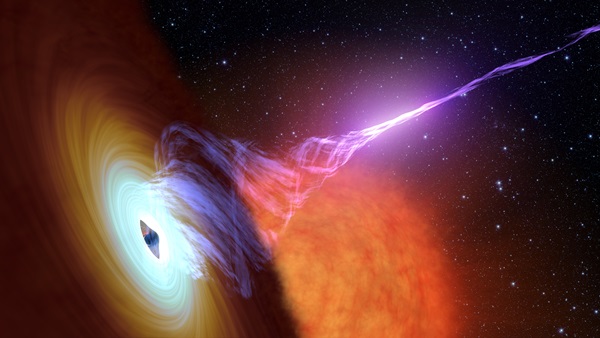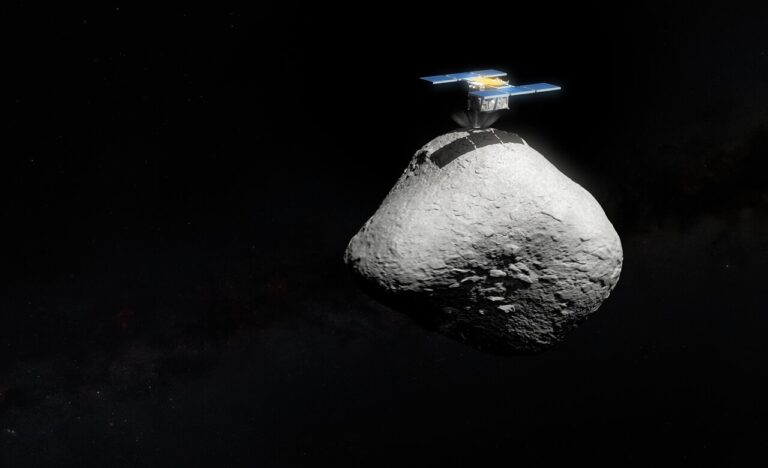Key Takeaways:
Black holes themselves are invisible, but the region around them is not. These objects are surrounded by an accretion disk of material, which can shine brightly across the electromagnetic spectrum. Many black holes also produce jets — collimated beams of material shot out from the poles before it can fall into the black hole. The physics behind these jets has eluded astronomers for decades, but now we are one step closer to understanding how they form and “light up.”
This breakthrough comes from dual observations of two black hole systems with NASA’s NuSTAR space telescope (which sees X-rays) and the ULTRACAM instrument (which looks at visible light) at the William Herschel Observatory in La Palma, Spain. By observing black holes in both X-rays and visible light, astronomers were able to zero in on particles in the jets, as they gained energy through acceleration and “turned on” or flared up in visible light. Measuring the time (and thus distance, called the “acceleration zone”) this takes and comparing it between different back hole systems provides valuable insight into how the jets are launched and how the particles in them behave. The work was published October 30 in Nature Astronomy.
In the study, the astronomers focused on two black hole systems: V404 Cygni and GX 339-4. Each system is classified as an X-ray binary, consisting of a black hole and a normal star. The black hole pulls material off its companion, which then feeds the accretion disk and jets. Of the two, GX 339-4 is a smaller system, with a black hole of about 6 solar masses much closer to its companion than the 12-solar-mass black hole and its companion in V404 Cygni.
These systems are not only different in terms of scale, but were also experiencing different types of activity during the observations. Black holes typically undergo erratic outbursts, which occur as material from the accretion disk brightens before falling into the black hole. GX 339-4 was extremely dim and inactive at the time of observation, while V404 Cygni was undergoing the brightest outburst seen in an X-ray binary system this century. The two very different scenarios allowed for an excellent comparison between the systems to see whether the size of the acceleration zone is related to factors such as the size of the system or its current activity.
To measure the acceleration zone, astronomers compared the time between when NuSTAR spotted X-rays from the system, and when ULTRACAM saw a flare in visible light. Making that simple measurement was actually extremely tricky, because it required coordinating between a telescope in orbit around Earth and one on the ground. Such coordination was only possible for about an hour in June 2015 during V404 Cygni’s outburst, but it was long enough to get the data needed.
In both systems, that delay came out to about 0.1 second — less than the time it takes to blink your eye. But even that tiny delay represents particles moving at the speed of light covering a distance of about 19,000 miles (30,000 kilometers) — the size of the acceleration zone. For reference, that distance is about three times the diameter of Earth.
This animation depicts the V404 Cygni system. Material from the companion star can be seen streaming onto the black hole’s accretion disk. As the disk flares due to infalling material, there is a slight delay as some particles are accelerated into the jets and become energetic enough to flare as well.
G Pérez Díaz (IAC)
Such a tiny distance holds important clues about jet formation and behavior, particularly because it was the same between the two systems.
“One possibility is that the physics of the jet is not determined by the size of the disc, but instead by the speed, temperature and other properties of particles at the jet’s base,” said lead author Poshak Gandhi, of the University of Southampton, United Kingdom, in a press release.
These results are also consistent with theories connecting the size of the acceleration zone to the mass of the black hole. In supermassive black hole systems, such as BL Lacertae (200 million solar masses), the time delay observed was millions of times greater than in the two smaller systems in this study.
“We are excited because it looks as though we have found a characteristic yardstick related to the inner workings of jets, not only in stellar-mass black holes like V404 Cygni, but also in monster supermassive ones,” Gandhi said.
Now, astronomers seek to make this time delay measurement for more systems, to see whether the acceleration zone is consistently relative to black hole size and further develop theories about the formation and activity of black hole jets.










